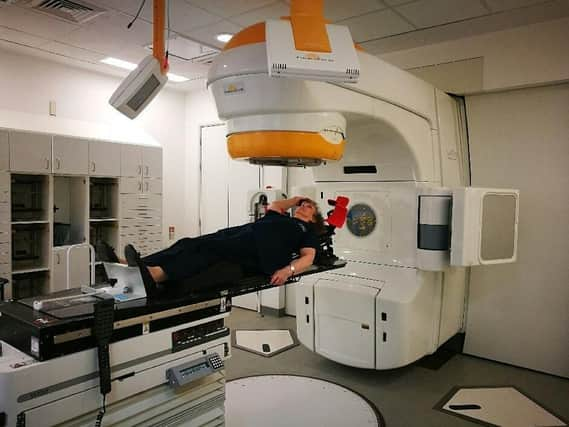A look inside the centre treating the borough's cancer patients


The patient’s life changes in those few words, as they face the battle with the disease and everything that brings.
Other news: Armed thug is jailed for robberyEach year around 400 patients from the Wigan borough are treated at a centre run by The Christie based at Salford Royal Hospital.
Advertisement
Hide AdAdvertisement
Hide AdOpened eight years ago, it provides radiotherapy treatment for patients, most of whom have been diagnosed with cancer.
It used to be that they would have to travel to The Christie’s centre in Withington, but now radiotherapy can be given in Salford for patients from Wigan, Bolton and Salford.
Gemma Dinn, who works as a Macmillan review radiographer, said: “We are still part of The Christie, but the idea of the satellite is to make us more accessible to the trust in Salford but also it’s more accessible to patients, so there’s less travelling involved.”
Lengthy journeys can take a real toll on patients who are already unwell, especially for those who need to attend every day for radiotherapy.
Advertisement
Hide AdAdvertisement
Hide AdSo the reduced distance makes a real difference to those going for treatment.
Nikki Martin, deputy manager and Macmillan review radiographer, said: “It has a massive impact on patients’ lives. If they are young and still working or have families, the reduced travelling times makes a massive difference.
“With that is reduced costs, reduced time away from work and reduced time away from the family.”
After being diagnosed with cancer, patients can be referred to the centre if they need radiotherapy.
Advertisement
Hide AdAdvertisement
Hide AdIt is one treatment available for cancer and can be used alongside or instead of chemotherapy and surgery.
It can be used to cure the cancer, reduce the chances of the cancer returning or shrink the tumour, for example so that surgery is easier to perform or to slow its progress.
Various types of cancers can be treated, with the most common including breast, prostate, lung and pancreas.
Radiotherapy involves a beam of X-rays being delivered to a precise area.
Advertisement
Hide AdAdvertisement
Hide AdThe radiation damages cells, but cancer cells are less able to repair the damage than normal cells, so they are destroyed.
Mrs Dinn said: “Radiotherapy is using strong X-rays. We target at a certain area, so we don’t treat the whole of the body it’s just certain areas.”
The patient meets a multi-disciplinary team of healthcare workers and their treatment is planned.
Mrs Dinn said: “Most patients would choose radiotherapy over surgery potentially because they can still work and have a day-to-day life. Sometimes chemotherapy isn’t an option.”
Advertisement
Hide AdAdvertisement
Hide AdA tattoo is put on the patient to mark the exact spot where the radiotherapy is needed.
In some cases a plastic mould will be needed to fit the treated area, such as the head, and this will be made as part of the preparation.
Patients are given a list of their appointments, so they know when they will need to be there.
Treatment can then get under way and that varies depending on the patient.
Advertisement
Hide AdAdvertisement
Hide AdMrs Dinn said: “When they come for radiotherapy treatment it can be having one treatment one day or coming here for six weeks. It depends on the treatment, there are a lot of factors.”
Patients being treated at The Christie’s centre can access free parking spaces right outside the building.
Efforts have been made to make the building feel less like a hospital and there are light boxes filled with plants to let the sunshine pour in.
Radiotherapy is provided by a large machine called a linear accelerator, which costs £2m.
Advertisement
Hide AdAdvertisement
Hide AdThe patient must lie completely still and green beams show the aim of the radiation.
Each session can take between 10 and 30 minutes, but the actual treatment only lasts a few minutes.
The radiographers operate the machine from outside the room, watching the patient on screens nearby to ensure everything is going to plan.
Mrs Dinn said: “We can’t tell on treatment if it’s working or not. We give everyone a break of two months after treatment to let all the side effects settle down and we assess from there.”
Advertisement
Hide AdAdvertisement
Hide AdSide effects from radiotherapy can vary and include tiredness, the skin going pink or looking sunburnt and nausea.
They are usually noticed during the second half of treatment and most have gone within eight weeks.
Mrs Dinn said: “The side effects are localised. It’s not usually too disruptive to the patient’s life, so a lot of patients continue working through treatment and they can bring themselves.”
Other support is available at the centre, such as a Macmillan Cancer Support information stand and CALMS, which helps patients’ well-being.
Advertisement
Hide AdAdvertisement
Hide AdPeople can also be signposted to services closer to their homes, such as district nurses and support groups.
Follow-up clinics are based in Wigan, allowing patients to be seen closer to home.
The Christie also treats patients at its main base in Withington and its centre at the Royal Oldham Hospital. It will open a proton beam therapy centre later this year.
The Christie is always looking for volunteers and fund-raisers wishing to give their support. To get involved, contact 0161 446 3988 or [email protected].